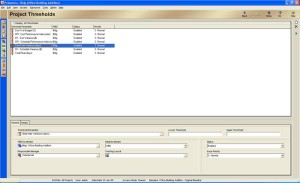Primavera P6 Training : Utilizing Thresholds in Primavera P6
Primavera P6 Training
What are thresholds in Primavera P6?
A threshold is a user-defined trigger that identifies when the status of an activity has exeeded or is close to moving beyond an acceptable range.
Thresholds are created by:
- Selecting a parameter ex. start date variance, cost variance, cost % of budget
- Set lower and upper values for the threshold’s range
- Apply the threshold to a specific work breakdown structure
When you create a threshold for a specific WBS element, you can specify how you monitor the WBS element.
- You can monitor the threshold at the activity level
- You can monitor the threshold at the WBS level.
The difference between the two ways of monitoring is how Primavera P6 EPPM groups issues. If you monitor a threshold at the activity level, then issues are created for each activity that violates the threshold’s range. If you monitor thresholds at the WBS level, then the activities’ issues will be summarized and reported at the WBS element, rather than each activity.
Once you have defined a threshold in Primavera P6, it can be monitored to identify whether it has any issues associated with it.
For example: Set up a threshold using the Total Float parameter.
- the lower threshold value is 1D
- the upper threshold value is 10D
An issue will be generated for any activites that have a total float less than or equal to 1D or more than or equal to 10D. Specific threshold tracking layouts and priority levels can also be assigned. A threshold’s tracking layout assignment identifies the tracking layout that best displays the threshold problem area.
This video tutorial was posted on our Youtube channel awhile ago, but we thought it was valuable enough to post again. It covers utilizing thresholds in Primavera Plus
Reader Interactions
This site uses Akismet to reduce spam. Learn how your comment data is processed.


Leave a Reply